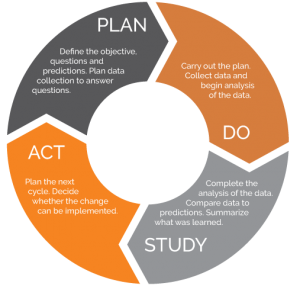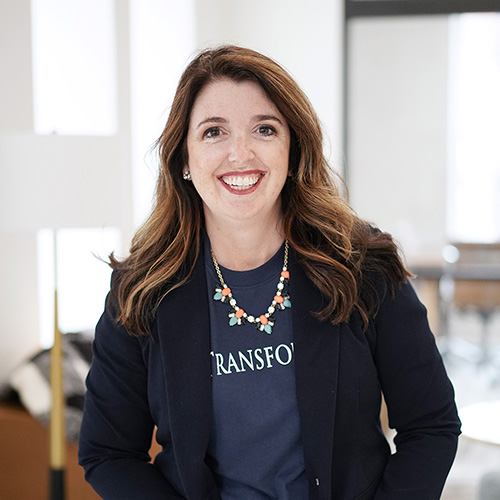 Too often non-profits and government agencies immediately begin implementing a new program or service area. They see a need with their clients or a gap in the existing services, so they elect to help meet that need. This all sounds good, right? The challenge is that there has not been enough time to complete a comprehensive planning and assessment process to develop the program or service. One service we offer our clients to meet this need is completing a feasibility study.
Too often non-profits and government agencies immediately begin implementing a new program or service area. They see a need with their clients or a gap in the existing services, so they elect to help meet that need. This all sounds good, right? The challenge is that there has not been enough time to complete a comprehensive planning and assessment process to develop the program or service. One service we offer our clients to meet this need is completing a feasibility study.
We follow the Plan-Do-Study-Act or “PDSA” continuous quality improvement cycle (learn more in this blog). We help clients assess, design, launch and evaluate programs and services in order to meet community needs and apply the latest research. When following this approach, we most often find that clients tend to skip the first step “Plan” and jump straight to “Do” as mentioned above. We work to help our clients thoughtfully plan out their services, programs, and interventions before they implement them to get the impact and desired change they are working towards.
Implementing a feasibility study is a great tool to complete a thoughtful planning process. A well designed feasibility study will help an organization assess 1) if what they are thinking of implementing is possible and 2) how to consider implementing it.
 We worked with a group of community leaders in Jay County to complete the feasibility of converting an old elementary school building into an early childhood center. Like many rural communities, Jay County has a declining population that has impacted their local schools in continuing to operate multiple school buildings, which has resulted in school consolidations and closures. At the same time, their rural community also struggles with attracting new employers due to a lack of child care for a growing workforce. Their community leaders had the idea of converting a closed elementary school into an early childhood center but wanted assistance in completing a feasibility study first.
We worked with a group of community leaders in Jay County to complete the feasibility of converting an old elementary school building into an early childhood center. Like many rural communities, Jay County has a declining population that has impacted their local schools in continuing to operate multiple school buildings, which has resulted in school consolidations and closures. At the same time, their rural community also struggles with attracting new employers due to a lack of child care for a growing workforce. Their community leaders had the idea of converting a closed elementary school into an early childhood center but wanted assistance in completing a feasibility study first.
4 Steps to Complete a Feasibility Study
1. Market Analysis
During this step you want to gather key information about your targeted population. This includes collecting demographic information from online public sources. This helps create a composite of your targeted community and population. We also suggest completing a landscape assessment to identify any other organization providing similar services or working with the target population. Lastly, it’s important to gather some qualitative feedback from various key stakeholders in the community to determine what they think the needs and gaps are as well as build community will for possibly launching a new service. This can be done through focus groups, surveys, and key informant interviews.
The purpose of this step is to ensure that there is in fact a need for your proposed program/ service. Check out this blog for more insight on completing a community needs assessment!
2. Program Design
During this step you will want to complete some research on your targeted service area. For Jay County, we are gathering the latest research on early childhood program models and services that lead to the desired outcomes they are seeking. Our landscape scan is also looking at existing program models in the community so as to not duplicate existing options but to consider complementary program models that will meet the needs of communities. If you are seeking external funding, you may want to adopt or align your program around research-based models that have demonstrated outcomes. This will provide confidence to potential funders in implementing a new program.
The purpose of this step is to determine the best model and design for implementing your program. Check out this blog for more tips on finding evidence-based programs.
3. Business Model
The next step is to develop the business model for operating the program. During this phase of the feasibility study you will gather important financial information that will help you understand what it will cost to implement the program and potential sources of funding. You should create a budget and possibly complete some financial forecasting to show start-up costs and when the program would “break even” or be self-sustaining. This step should also assess the operations behind implementing the program, which includes the staffing model, materials and services, training, facility, technology, equipment and other program needs.
With Jay County, we completed walk-throughs of three possible locations with an architect and construction group to inform the best location to operate an early childhood center. This informed the potential capacity to serve children, the staffing needs and ultimately budget the break down for start-up costs versus ongoing maintenance costs. The purpose of this step is to think through all of the components needed to successfully implement the program.
Check out this blog for some tips to establish financial goals.
4. Communications Plan
The last (and sometimes forgotten) step is to develop a communications strategy if you decide to launch the new program. After spending all of this time assessing and planning the design of the program, you want to ensure that the targeted audience knows about the program and enrolls/ participates. The communications plan would include determining the current knowledge base in the community, so there might need to be some education and awareness about why you are providing this service especially if it is new and different.
In Jay County, we are created a PR Campaign through a series of op-eds penned by different key stakeholders (employers, teachers, judge, doctor, etc.) in the community all talking about why expanding early childhood is critical to meet the community’s needs. Your communications plan should include the different channels (social media, newspaper, radio, text, mailings, etc.) that residents use to gather information. In a parent survey (our potential client for early childhood services), we asked them where they get their information and their preferred method of communication. Based on this assessment, develop a start-up marketing plan and community education plan for the proposed new program that will meet participation goals and engage the key stakeholders and partners in the community.
Check out this blog for tips on creating an op-ed campaign and this blog for getting media attention.
Completing a feasibility study may seem unnecessary or slow down your timeline, but the time you invest up front will see a return in a well thought out model that will be set up for success and to accomplish your goals. Completing intentional design through the PDSA model is a critical differentiator for Transform Consulting Group and many clients point specifically to this process improving their own internal operations which accelerates impact. Contact us if we can help you complete a feasibility study!

